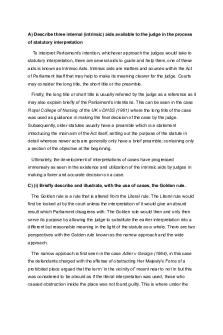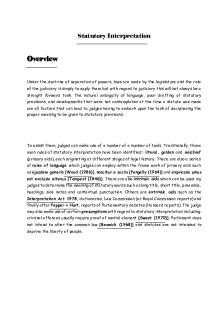Statutory Interpretation PDF

| Title | Statutory Interpretation |
|---|---|
| Author | Cheow J-ann |
| Course | Law |
| Institution | University of Reading |
| Pages | 3 |
| File Size | 66.6 KB |
| File Type | |
| Total Downloads | 55 |
| Total Views | 158 |
Summary
Statutory Interpretation Example Questions....
Description
A) Describe three internal (intrinsic) aids available to the judge in the process of statutory interpretation To interpret Parliament’s intention, whichever approach the judges would take to statutory interpretation, there are several aids to guide and help them, one of these aids is known as Intrinsic Aids. Intrinsic aids are matters and sources within the Act of Parliament itself that may help to make its meaning clearer for the judge. Courts may consider the long title, the short title or the preamble. Firstly, the long title or short title is usually referred by the judge as a reference as it may also explain briefly of the Parliament’s intentions. This can be seen in the case Royal College of Nursing of the UK v DHSS (1981) where the long title of the case was used as guidance in making the final decision of the case by the judge. Subsequently, older statutes usually have a preamble which is a statement introducing the main aim of the Act itself, setting out the purpose of the statute in detail whereas newer acts are generally only have a brief preamble; containing only a section of the objective at the beginning. Ultimately, the development of interpretations of cases have progressed immensely as seen in the existence and utilization of the intrinsic aids by judges in making a fairer and accurate decision on a case. C) (i) Briefly describe and illustrate, with the use of cases, the Golden rule. The Golden rule is a rule that is altered from the Literal rule. The Literal rule would first be looked at by the court unless the interpretation of it would give an absurd result which Parliament disagrees with. The Golden rule would then and only then serve its purpose by allowing the judge to substitute the earlier interpretation into a different but reasonable meaning in the light of the statute as a whole. There are two perspectives with the Golden rule known as the narrow approach and the wide approach. The narrow approach is first seen in the case Adler v George (1964), in this case the defendants charged with the offense of obstructing Her Majesty’s Force of a prohibited place argued that the term ‘in the vicinity of’ meant near to not in but this was considered to be absurd as if the literal interpretation was used, those who caused obstruction inside the place was not found guilty. This is where under the
narrow application of the golden rule, the court may only choose between the possible meanings of the word or phrase unless there is only one meaning then that must be taken. The wide approach is seen in the case Re Sigsworth (1935), a son would be made beneficiary of the mother with no will whom he murdered as there was no ambiguity in the literal meaning of the act if the literal rule was used by the court. This meant that her murderer son would have inherited as her ‘issue’. Therefore, the golden rule is applied by the court to modify the words of the Act that has only one meaning, this is to avoid and prevent the ridiculous situation if the literal meaning of the act was used instead of the wide approach in the golden rule. Overall, the Golden rule provides more discretion and flexibility in the law compared to if judges could only apply the Literal rule in cases. This allows judges to choose the most sensible meaning and make the best decisions depending on the case itself. Moreover, it provides an option for the judge to avoid repugnant situations. (ii) Discuss the advantages and disadvantages of the purposive approach The purposive approach is a recent approach adopted by the Courts. The purposive approach is much different than the mischief rule as it focuses on what Parliament intended to achieve when passing the new law. It is commonly regarded as the modern version of the mischief rule. There are several advantages that comes with the application of the purposive approach. Firstly, it allows and gives more discretion towards the judges. Instead of following the literal meaning of the Act given, judges are able to avoid repugnant situations and make sensible decisions based on the facts of the case. It also makes sense to examine the real intention and purpose behind the Act before making the final decision. The purposive approach also gives effect to the Parliament’s intentions on the origin of the Act itself as judges could prevent making rash decisions thus complying with the Act’s main purpose. This approach will also prevent rigidity in the law and allows judges to use their own logic and rational in reviewing the case.
There are disadvantages that come along with the approach as well. Judges researching with the intention of finding the purpose of the statue may prove to be difficult and time consuming as they would have to go through intrinsic or extrinsic aids to obtain it. Furthermore, it reduces the certainty in the law and causes decisions in the court to be unpredictable if the judge interprets it in a different way. Moreover, it may cause public disagreement as it reduces confidence in the statute and may provide too much freedom for the judge in making decisions and interpretations of the law. In conclusion, the purposive approach can be viewed and debated in different perspectives. The introduction and existence of the purposive approach in the law system proves that the law is constantly and consistently changing throughout the years along with society therefore it may improve or deteriorate....
Similar Free PDFs

Statutory Interpretation
- 6 Pages

Statutory Interpretation
- 6 Pages

Statutory Interpretation
- 3 Pages

Statutory Interpretation
- 5 Pages

Statutory Interpretation
- 11 Pages

Statutory Interpretation
- 6 Pages

Statutory interpretation notes
- 2 Pages

Statutory Interpretation 70102
- 5 Pages

Statutory Interpretation in Malaysia
- 12 Pages

Statutory Interpretation Notes
- 9 Pages

Statutory Interpretation Notes
- 4 Pages
Popular Institutions
- Tinajero National High School - Annex
- Politeknik Caltex Riau
- Yokohama City University
- SGT University
- University of Al-Qadisiyah
- Divine Word College of Vigan
- Techniek College Rotterdam
- Universidade de Santiago
- Universiti Teknologi MARA Cawangan Johor Kampus Pasir Gudang
- Poltekkes Kemenkes Yogyakarta
- Baguio City National High School
- Colegio san marcos
- preparatoria uno
- Centro de Bachillerato Tecnológico Industrial y de Servicios No. 107
- Dalian Maritime University
- Quang Trung Secondary School
- Colegio Tecnológico en Informática
- Corporación Regional de Educación Superior
- Grupo CEDVA
- Dar Al Uloom University
- Centro de Estudios Preuniversitarios de la Universidad Nacional de Ingeniería
- 上智大学
- Aakash International School, Nuna Majara
- San Felipe Neri Catholic School
- Kang Chiao International School - New Taipei City
- Misamis Occidental National High School
- Institución Educativa Escuela Normal Juan Ladrilleros
- Kolehiyo ng Pantukan
- Batanes State College
- Instituto Continental
- Sekolah Menengah Kejuruan Kesehatan Kaltara (Tarakan)
- Colegio de La Inmaculada Concepcion - Cebu




